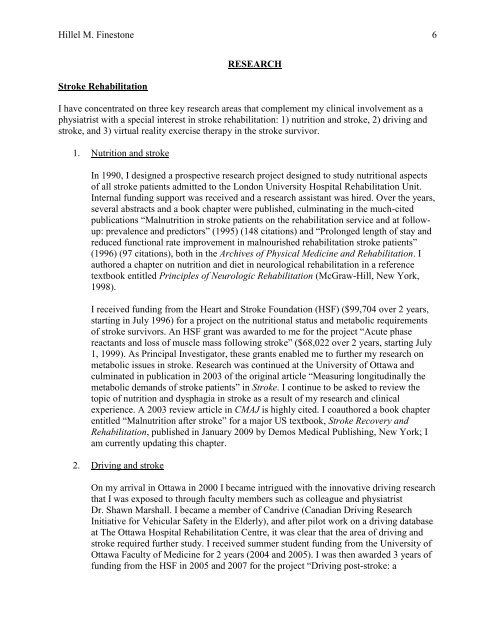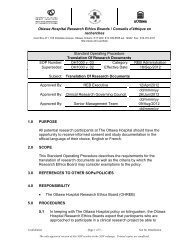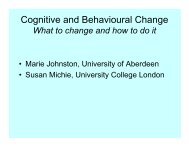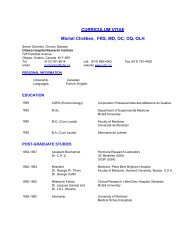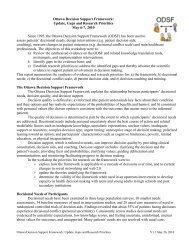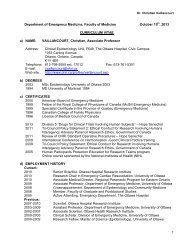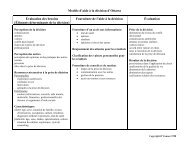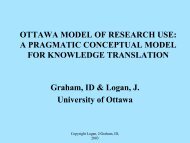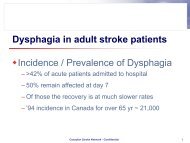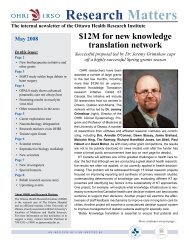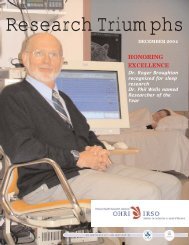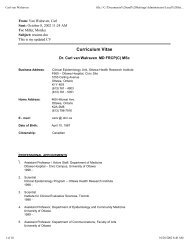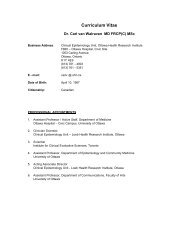CURRICULUM VITAE - The Ottawa Hospital Research Institute
CURRICULUM VITAE - The Ottawa Hospital Research Institute
CURRICULUM VITAE - The Ottawa Hospital Research Institute
Create successful ePaper yourself
Turn your PDF publications into a flip-book with our unique Google optimized e-Paper software.
Hillel M. Finestone 6<br />
Stroke Rehabilitation<br />
RESEARCH<br />
I have concentrated on three key research areas that complement my clinical involvement as a<br />
physiatrist with a special interest in stroke rehabilitation: 1) nutrition and stroke, 2) driving and<br />
stroke, and 3) virtual reality exercise therapy in the stroke survivor.<br />
1. Nutrition and stroke<br />
In 1990, I designed a prospective research project designed to study nutritional aspects<br />
of all stroke patients admitted to the London University <strong>Hospital</strong> Rehabilitation Unit.<br />
Internal funding support was received and a research assistant was hired. Over the years,<br />
several abstracts and a book chapter were published, culminating in the much-cited<br />
publications “Malnutrition in stroke patients on the rehabilitation service and at followup:<br />
prevalence and predictors” (1995) (148 citations) and “Prolonged length of stay and<br />
reduced functional rate improvement in malnourished rehabilitation stroke patients”<br />
(1996) (97 citations), both in the Archives of Physical Medicine and Rehabilitation. I<br />
authored a chapter on nutrition and diet in neurological rehabilitation in a reference<br />
textbook entitled Principles of Neurologic Rehabilitation (McGraw-Hill, New York,<br />
1998).<br />
I received funding from the Heart and Stroke Foundation (HSF) ($99,704 over 2 years,<br />
starting in July 1996) for a project on the nutritional status and metabolic requirements<br />
of stroke survivors. An HSF grant was awarded to me for the project “Acute phase<br />
reactants and loss of muscle mass following stroke” ($68,022 over 2 years, starting July<br />
1, 1999). As Principal Investigator, these grants enabled me to further my research on<br />
metabolic issues in stroke. <strong>Research</strong> was continued at the University of <strong>Ottawa</strong> and<br />
culminated in publication in 2003 of the original article “Measuring longitudinally the<br />
metabolic demands of stroke patients” in Stroke. I continue to be asked to review the<br />
topic of nutrition and dysphagia in stroke as a result of my research and clinical<br />
experience. A 2003 review article in CMAJ is highly cited. I coauthored a book chapter<br />
entitled “Malnutrition after stroke” for a major US textbook, Stroke Recovery and<br />
Rehabilitation, published in January 2009 by Demos Medical Publishing, New York; I<br />
am currently updating this chapter.<br />
2. Driving and stroke<br />
On my arrival in <strong>Ottawa</strong> in 2000 I became intrigued with the innovative driving research<br />
that I was exposed to through faculty members such as colleague and physiatrist<br />
Dr. Shawn Marshall. I became a member of Candrive (Canadian Driving <strong>Research</strong><br />
Initiative for Vehicular Safety in the Elderly), and after pilot work on a driving database<br />
at <strong>The</strong> <strong>Ottawa</strong> <strong>Hospital</strong> Rehabilitation Centre, it was clear that the area of driving and<br />
stroke required further study. I received summer student funding from the University of<br />
<strong>Ottawa</strong> Faculty of Medicine for 2 years (2004 and 2005). I was then awarded 3 years of<br />
funding from the HSF in 2005 and 2007 for the project “Driving post-stroke: a


